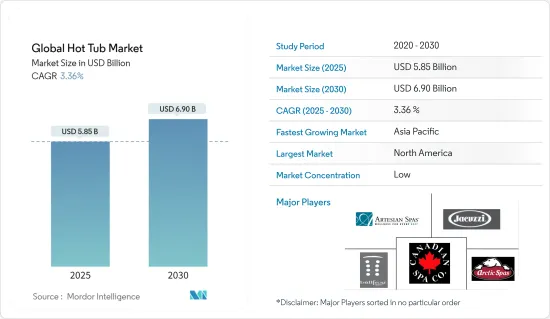PUBLISHER: Mordor Intelligence | PRODUCT CODE: 1687883

PUBLISHER: Mordor Intelligence | PRODUCT CODE: 1687883
Global Hot Tub - Market Share Analysis, Industry Trends & Statistics, Growth Forecasts (2025 - 2030)
The Global Hot Tub Market size is estimated at USD 5.85 billion in 2025, and is expected to reach USD 6.90 billion by 2030, at a CAGR of 3.36% during the forecast period (2025-2030).

Generally, hot tubs are made of wood, cement, stainless steel, and glass fiber, and they provide various health benefits. These include relief from stress, minimization of arthritis pain, reduction of diabetic blood sugar levels, and lowering of blood pressure.
The COVID-19 outbreak has been causing an economic slowdown all over the world. As the hot tub market is widely considered a part of the luxury goods sector, the market is highly sensitive to economic cycles. The economic recession worldwide has seriously hampered the demand for these products, especially the high- and premium segments of the market. Many governments and health organizations are suggesting not to travel and as there are still restrictions on holiday travel. There is crashing in the commercial segment of the market as many wellness centers, luxury hotels, spas, and gymnasiums are closed to reduce human contact, as the main prevention for COVID-19 is physical distancing. A temporary shift in consumer behavior in terms of luxury products is forecasted but it may last for a shorter period, and once the economy starts to bounce back, the demand for the products may increase with gaining consumer interests.
Rise in disposable income, an increase in awareness about health, changing lifestyles of individuals, and rapid technological advancements are some of the major factors expected to drive the hot tub market. Manufacturers are focusing on launching innovative hot tubs with energy-efficient features.
The multi-functionality of hot tubs is another factor anticipated to boost the hot tub market as multi-functional hot tubs provide more space for swimming and workout compared to rectangular hot tubs. These features are also propelling the demand for solar hot tubs across the world.
Rapid urbanization is also anticipated to drive the hot tub market during the forecast period. However, fluctuations in prices of raw materials are likely to hamper the market growth during the forecast period.
Hot Tub Market Trends
The Commercial End User Segment is Anticipated to Grow at a Higher Rate
Based on end-users, the hot tub market can be divided into residential and commercial. The commercial segment includes hotels, spas and salons, and other commercial end-users. Under the end-user segments, the commercial segment is expected to grow at a faster rate during the forecast period. The rapid growth in the hotel and salon and spa industry is the key factor expected to accelerate the hot tub market during the forecast period.
Asia-Pacific is Expected to Witness the Highest Growth
By geography, the hot tub market is divided into Asia-Pacific, Europe, North America, Middle-East and Africa, and Latin America. Asia-Pacific is anticipated to be the rapidly growing region of the market, followed by Europe and North America, during the forecast period.
The growing urbanization and rising purchasing power of consumers in the region, especially from China and India, are expected to drive the growth of the market in the region. One of the key factors boosting this growth is the increasing investments in the residential and commercial sectors.
Hot Tub Industry Overview
The report covers the major international players operating in the hot tub market. In terms of market share, few of the major players currently dominate the market. However, the demand is driven by consumer income. Large companies compete through volume purchasing, breadth of products, and effective merchandising and marketing. Small companies focus on a market segment and compete through the depth of products and superior customer service.
Additional Benefits:
- The market estimate (ME) sheet in Excel format
- 3 months of analyst support
TABLE OF CONTENTS
1 INTRODUCTION
- 1.1 Study Assumptions and Market Definition
- 1.2 Scope of the Study
2 RESEARCH METHODOLOGY
3 EXECUTIVE SUMMARY
4 MARKET INSIGHTS AND DYNAMICS
- 4.1 Market Overview
- 4.2 Drivers
- 4.3 Restraints
- 4.4 Opportunities
- 4.5 Trends Influencing the Hot Tub Market
- 4.6 Porter's Five Forces Analysis
- 4.7 Supply Chain/Value Chain Analysis of the Hot Tub Market
- 4.8 Technological Innovations
- 4.9 Impact of COVID-19 on the Market
5 MARKET SEGMENTATION
- 5.1 Type
- 5.1.1 Portable Hot Tubs
- 5.1.2 Fixed Hot Tubs
- 5.2 End User
- 5.2.1 Residential
- 5.2.2 Commercial
- 5.3 Geography
- 5.3.1 North America
- 5.3.2 Europe
- 5.3.3 Asia-Pacific
- 5.3.4 Latin America
- 5.3.5 Middle-East and Africa
6 COMPETITIVE LANDSCAPE
- 6.1 Company Profiles
- 6.1.1 Bullfrog Spas
- 6.1.2 Canadian Spa Company
- 6.1.3 Jacuzzi Brands
- 6.1.4 Artesian Spas
- 6.1.5 Blue Falls Manufacturing
- 6.1.6 Cal Spas
- 6.1.7 Nordic Hot Tubs
- 6.1.8 Coast Hot Tubs
- 6.1.9 Caldera Spas
- 6.1.10 PDC Spas
- 6.1.11 Other Companies (Beachcomber, Viking Spas, Catalina Spas, Master Spas and Hot Tubs, Atera Anytemp, Maax Spas, Marquis Spas, and Dynasty Spas)
7 FUTURE OF THE MARKET
8 DISCLAIMER




